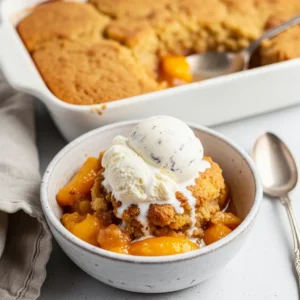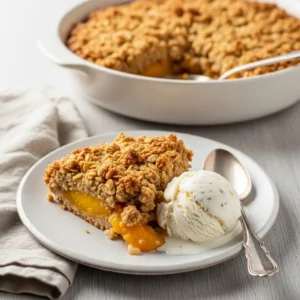This is the ultimate crusted halibut recipe you’ve been searching for. It delivers a restaurant-quality meal with a shatteringly crispy, golden-brown crust and a perfectly moist, flaky fish center. Forget soggy toppings or dry, overcooked fish; this foolproof method combines savory Parmesan, bright lemon zest, and crunchy Panko breadcrumbs for an unforgettable texture and flavor. Best of all, it’s incredibly easy and ready in under 30 minutes, making it a perfect weeknight dinner that feels truly special.
We’ll show you how to get that perfect crust using two simple methods—baking or pan-searing—so you can achieve a flawless result every single time.
Why This is the Best Crusted Halibut Recipe
If you’re looking for a go-to fish recipe, this is it. Here’s why you’ll fall in love with this dish:
- Incredible Flavor & Texture: The combination of the rich, nutty Parmesan, fresh lemon zest, garlic, and herbs creates a savory topping that perfectly complements the mild, sweet flavor of the halibut. The Panko ensures it gets unbelievably crispy.
- Foolproof Method: We use a simple trick with Dijon mustard that not only adds a layer of flavor but also acts as the perfect binder, ensuring the crust sticks to the fish and doesn’t fall off during cooking.
- Quick & Easy for Weeknights: With just 10 minutes of prep and about 15 minutes of cooking, you can have a gourmet-level meal on the table in less than half an hour.
- Versatile Cooking Options: Whether you prefer the hands-off ease of baking or the extra-crispy results from pan-searing, this recipe includes clear instructions for both.
Ingredients You’ll Need
The magic of this recipe lies in its simple, high-quality ingredients. The topping comes together in minutes and transforms the beautiful halibut fillets into a masterpiece.
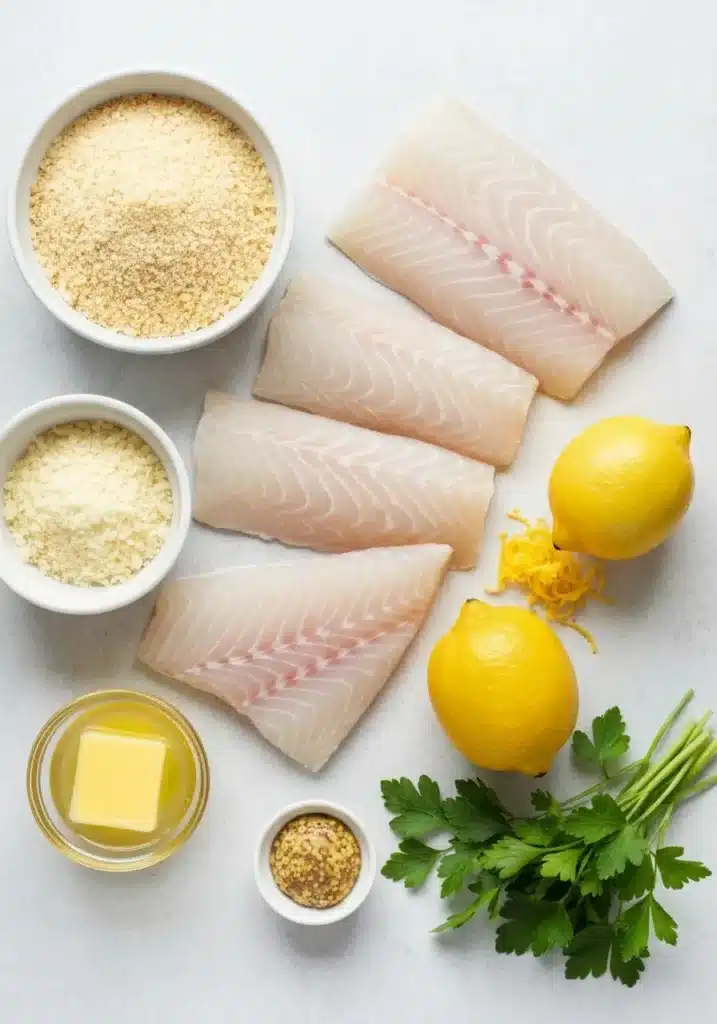
For the Halibut
- Halibut Fillets: You’ll need four 6-ounce fillets, about 1 to 1.5 inches thick. Look for firm, white fillets. You can use fresh or frozen (and thawed).
- Salt & Black Pepper: To season the fish and enhance all the other flavors.
- Olive Oil: A little for cooking, especially if pan-searing.
For the Lemon Parmesan Crust
- Panko Breadcrumbs: This is the key to a light, airy, and super crispy crust. Do not substitute with regular breadcrumbs.
- Parmesan Cheese: Use freshly grated Parmesan for the best flavor and melting quality. It adds a salty, nutty depth.
- Lemon Zest: Provides a bright, fresh aroma and flavor that cuts through the richness.
- Melted Butter: Helps toast the Panko to a perfect golden brown and adds richness.
- Fresh Parsley: Finely chopped parsley adds a touch of color and fresh, herby flavor.
- Garlic Powder: For a gentle, savory garlic note that doesn’t overpower the delicate fish.
- Dijon Mustard: Our secret weapon! A thin layer is the perfect glue for the crust and adds a subtle tangy flavor.
How to Make Crusted Halibut (Step-by-Step)
Follow these simple steps for a flawless meal. We’re providing instructions for both baking (the easiest method) and pan-searing (for an extra-crispy crust).
Step 1: Prepare the Halibut
First, gently pat the halibut fillets completely dry with a paper towel. This is a critical step for getting a good sear and helping the crust adhere properly. Season both sides of the fillets generously with salt and freshly ground black pepper.
Step 2: Make the Panko Topping
In a shallow bowl or on a plate, combine the Panko breadcrumbs, freshly grated Parmesan cheese, lemon zest, chopped parsley, and garlic powder. Pour the melted butter over the mixture and toss with a fork until all the breadcrumbs are lightly coated. It should resemble damp sand.
Step 3: Coat the Fish
Using a pastry brush or the back of a spoon, spread a thin, even layer of Dijon mustard over the top surface of each halibut fillet. Then, press the Panko mixture firmly onto the mustard-coated side, creating a thick, even crust. The mustard acts as a delicious binder.
Step 4: Cook the Halibut (Two Ways!)
Choose the method that works best for you. Both yield delicious results!
Option 1: Baked Crusted Halibut (Easiest Method)
Preheat your oven to 400°F (200°C). Place the crusted halibut fillets on a baking sheet lined with parchment paper. Bake for 12-15 minutes, or until the crust is golden brown and the fish is opaque and flakes easily with a fork. The internal temperature should reach 130-135°F (54-57°C).
Option 2: Pan-Seared Crusted Halibut (Extra Crispy)
Heat a tablespoon of olive oil in a large non-stick skillet over medium-high heat. Carefully place the halibut fillets crust-side down in the hot pan. Sear for 3-4 minutes until the crust is a deep golden brown. Gently flip the fillets using a fish spatula and cook for another 3-5 minutes on the other side, until the fish is cooked through. For a similar crispy result without all the oil, you can also try making a Quick & Crispy Air Fryer Halibut Recipe.
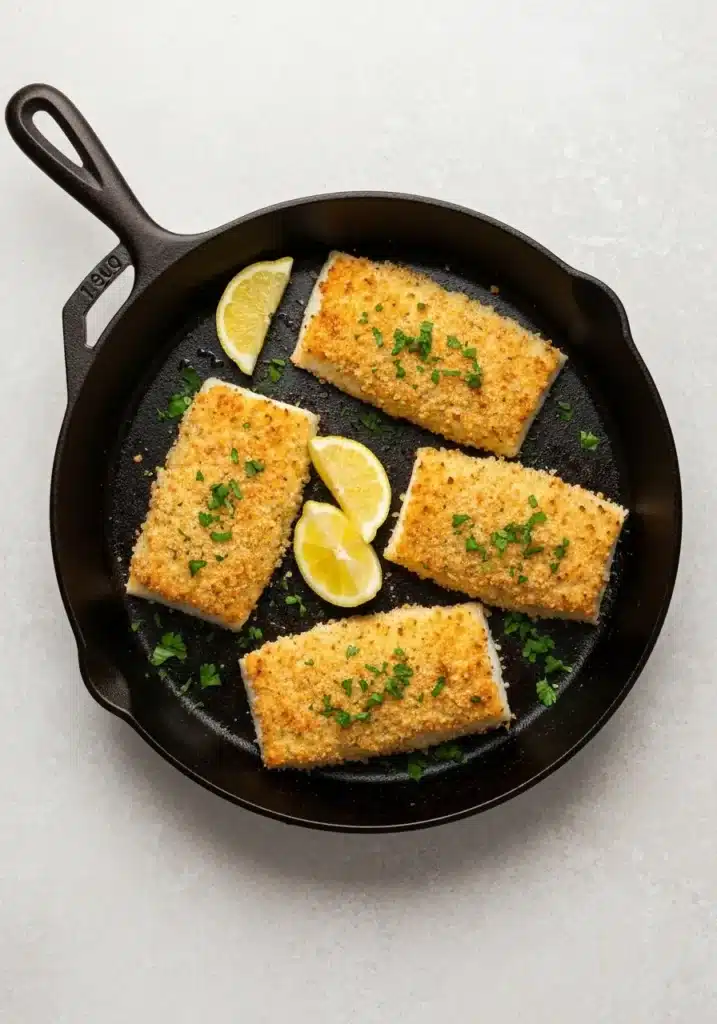
Tips for a Flawless, Flaky Finish
- Don’t Skip Patting Dry: Moisture is the enemy of a crispy crust. A dry surface ensures the mustard and topping adhere perfectly.
- Use Panko, Not Regular Breadcrumbs: Panko breadcrumbs are lighter and flakier, creating a much crispier texture than standard breadcrumbs. If you enjoy a crunchy coating, you might also like this simple oven-baked breaded halibut.
- Press the Topping Firmly: Gently but firmly press the Panko mixture onto the fillets to ensure it forms a compact layer that won’t fall off.
- Don’t Overcook: Halibut cooks quickly and can become dry. The best way to check for doneness is with an instant-read thermometer (130-135°F). If you don’t have one, the fish should flake easily with a fork when done.
Variations and Substitutions
This recipe is fantastic as is, but it’s also easy to adapt. Here are a few ideas:
| Substitution/Variation | How to Do It |
|---|---|
| Nut Crust | Replace half of the Panko with finely chopped almonds, pecans, or walnuts for a nutty flavor and extra crunch. |
| Different Herbs | Swap the parsley for fresh dill, thyme, or chives. |
| Gluten-Free | Use gluten-free Panko breadcrumbs. All other ingredients are naturally gluten-free. |
| Different Fish | This crust works beautifully on other firm white fish like cod, sea bass, or mahi-mahi. Adjust cooking times based on thickness. |
What to Serve with Crusted Halibut
This elegant main course pairs well with a variety of sides. For a complete and balanced meal, try serving it with:
- Roasted Vegetables: Roasted asparagus, green beans, or broccoli are classic choices.
- Starches: Creamy risotto, lemon-herb couscous, or simple roasted potatoes.
- Salads: A light green salad with a lemon vinaigrette.
Storage and Reheating Instructions
Store leftover halibut in an airtight container in the refrigerator for up to 2 days. To reheat and maintain crispiness, place it on a baking sheet in a 350°F (175°C) oven or in an air fryer for 5-7 minutes, until warmed through. Avoid the microwave, as it will make the crust soggy.
The Perfect Crusted Halibut Recipe
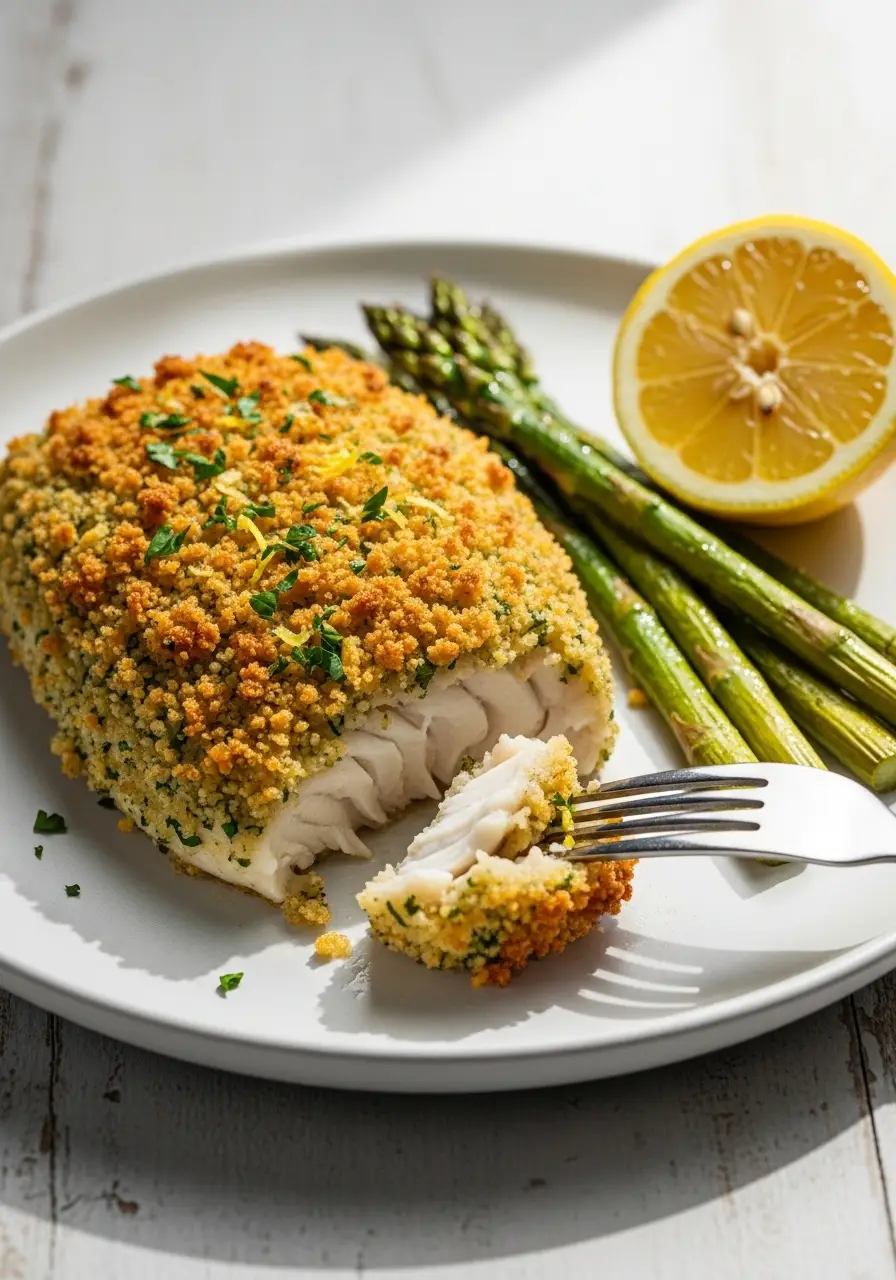
Crusted Halibut Recipe with Lemon, Parmesan, and Panko
Ingredients
Equipment
Instructions
- Pat the halibut fillets completely dry with a paper towel. Season both sides generously with salt and pepper.
- In a shallow bowl, combine the Panko breadcrumbs, grated Parmesan, lemon zest, chopped parsley, and garlic powder. Drizzle with melted butter and toss with a fork until the mixture is evenly moistened.
- Spread a thin, even layer of Dijon mustard over the top of each halibut fillet. Firmly press the Panko mixture onto the mustard to create a thick crust.
- Preheat oven to 400°F (200°C). Place the fillets on a parchment-lined baking sheet. Bake for 12-15 minutes, until the crust is golden and the fish flakes easily (internal temp of 130-135°F).
- Heat olive oil in a large non-stick skillet over medium-high heat. Place halibut crust-side down and sear for 3-4 minutes until golden brown. Gently flip and cook for another 3-5 minutes until the fish is cooked through.
- Serve immediately, garnished with extra fresh parsley and a lemon wedge on the side.
Notes
Tip 2: Patting the fish dry is a crucial step to ensure the crust adheres properly.
Tip 3: Don't overcook the halibut! Use a thermometer for perfect results. The fish will continue to cook slightly after being removed from the heat.
Frequently Asked Questions About Crusted Halibut Recipe
Yes, you can. Just make sure to thaw the halibut completely before you begin. Pat it extra dry with paper towels to remove any excess moisture from freezing, then proceed with the recipe as written.
The secret is to first pat the halibut fillets completely dry, then spread a thin layer of Dijon mustard on top before pressing the Panko mixture on. The mustard acts as a flavorful glue, ensuring the crust adheres perfectly during cooking.
If you don’t have a thermometer, you can check for doneness by inserting a fork into the thickest part of the fillet and gently twisting. The fish should be opaque and flake apart easily. If it’s still translucent or resists flaking, it needs a little more time.
To make this recipe gluten-free, simply substitute the Panko breadcrumbs with gluten-free Panko. You can also use finely crushed gluten-free crackers, almond flour, or a combination of both for a delicious crispy crust.
For moist and flaky halibut, cook it to an internal temperature of 130-135°F (54-57°C). Use an instant-read thermometer for the most accurate results. The fish will continue to cook slightly after you remove it from the heat.
More Delicious Halibut Recipes to Try
If you loved this crusted halibut, you’re sure to enjoy exploring other ways to prepare this fantastic fish. For an even simpler approach, try this simple baked halibut. And if you loved the golden crust from the skillet method, don’t miss our classic pan-seared halibut for a perfect sear every time.
We hope this becomes your new favorite fish recipe! If you make it, please leave a comment below and let us know how it turned out. Don’t forget to save it to your dinner board on Pinterest!


